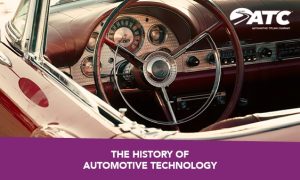
The automotive industry has always been a hotbed of technological innovation so ATC has put together our list of the most important automotive technology advances to show just how far we’ve come in the last 100+ years.
1911 – Electric Ignition
Before electric ignition, manual hand cranks started cars, but they were dangerous because the engine could jump as the car started, injuring the driver. The first electric starter appeared in a Cadillac in 1912.
1921 – Cigarette Lighters
Cigarette lighters were standard by around 1925, and although they aren’t common today, we still use the socket to power our in-car electronics.
1930 – Car Radio
The first car radios were AM, and 22 years later the first FM radio was available.
1949 – Car Keys
Chrysler invented the car key to start the electric starter and ignition. Soon, every manufacturer offered keys.
1951 – Power Steering
Power steering uses hydraulic power to make steering much easier, and first appeared on a Chrysler in 1951, and a Cadillac a year later.
1953 – Air Conditioning
The Chrysler Imperial was the first car to offer air conditioning as an option, making summer driving more bearable.
1958 – Cruise Control
Once again, Chrysler led the way with cruise control in 1958, and was soon a standard feature in Cadillacs a few years later.
1959 – Seatbelts
The modern seatbelt was invented by Volvo, who decided to give away the patent to other carmakers for free, knowing it would save lives.
1971 – ABS Technology
An Anti-Lock Braking System stops wheels from locking up during hard braking. It was first used on trains before Chrysler adapted it for the car.
1973 – Catalytic Converter
This technology reduces toxic emissions created by the engine.
1988 – Airbags
Chrysler introduced the first production airbag, which was initially only available for the driver.
1994 – On-board Diagnostics
OBD allows mechanics to access information about the car in order to make repairs. OBD became mandatory in 1996.
1996 – Electric Vehicle
The GM EV1 was the first mass-produced electric vehicle and even though GM promised 70-90 miles on a charge, it was actually closer to 50-60 miles.
1998 – Smart Key
Mercedes-Benz was the first to offer the Smart Key, which allowed the car to be started using a push button as long as the key was inside the vehicle.
2000 – GPS Navigation
In 2000, President Bill Clinton ordered the military to stop scrambling GPS signals which made the technology available for use in auto navigation systems.
2000 – Hybrid cars
Adding an electric motor to a gas engine was first conceived in the 19th century but Toyota brought it to the world market in 2000.
2001 – Bluetooth
The first hands-free bluetooth appeared in 2001 and today bluetooth is integrated with every car’s infotainment system.
2002 – Backup Camera
The first backup camera was used in the 1956 Buick Centurion concept car, which was never produced, so the 2002 Infiniti Q45 was the first production car to offer it.
Some items on this list seem so basic today that calling them “technology advances” seems strange, but to anyone that remembers craning their neck to see what was behind them as they backed up, or wrestling with the steering wheel before power steering was a thing, they are miracles of technology!
What does the future hold for automotive technology? Autonomous vehicles get the lion’s share of attention, but what else is coming to our cars?
?? – Gesture Controls
Automakers are working on displays that respond to gesture control.
?? – Biometric access
The smart key is so 2010! Someday soon you’ll unlock and start your car with your fingerprint.
?? – Windshield Displays
One day everything your dash shows you will be displayed in your smart glass windshield.
?? – Energy-storing Body Panels
The battery required for an electric vehicle takes up a lot of space (and weight) so automakers are developing energy-storing body panels that take the place of the battery.
ATC is also in the automotive technology business – we provide dealers, lenders, and auto technologies accurate tax, title, and license data for in-state and out-of-state vehicle titling and registration. No matter what technology makes its way to our cars in the future, we know that each car will still have to be registered and licensed. Contact us for more information about how our technology helps increase car sales and remove friction from the car buying experience.



